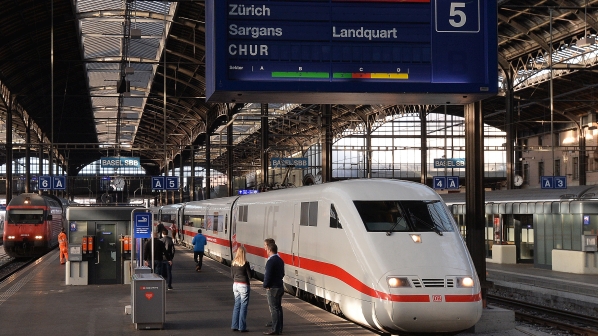Government intervention is expected to mitigate the negative effects of the coronavirus pandemic on the sector, Moody’s says. However, government support will allow the sector to preserve its credit quality, despite the plummet in railway companies’ earnings in 2020, the credit rating provider notes.
Moody’s says environmental trends are expected to create growth opportunities in the next decade. Initiatives by European governments to tackle air pollution and cut greenhouse gas emissions will provide a boost to rail traffic due to its low CO2 emissions compared with other forms of transport.
“Environmental trends will create growth opportunities for European passenger railway companies in the next decade, a credit positive given the impact of the coronavirus on the sector,” says Mr Francesco Bozzano, assistant vice president, analyst at Moody’s Investors Service. “Government initiatives encouraging consumers to use more sustainable transport alternatives to reduce CO2 emissions should also mean a profit boost to rail traffic.”
In general, Moody’s expects passenger traffic to recover more quickly in the rail sector than in the airline sector where a substantial recovery is unlikely before 2023. The faster recovery is driven by the lower exposure of passenger operators to international traffic, which accounts for only 6% of European rail passenger traffic, and also by the increasing use of rail as a form of transport.
While leisure travel will fully recover, Moody’s says it believes there is a risk that business travel may not return to 2019 levels as it expects a permanent increase in people working from home instead of commuting to an office.
Overall, Moody’s expects traffic to recover from the 2020 level then grow slightly above GDP from 2022, which will support long-term revenue growth for European passenger railway companies.
Government support
While European governments have required operators to continue running throughout 2020 to allow essential journeys during the pandemic, the significant drop in passenger traffic has led to a substantial decline in rail operators’ Ebitda, especially during the first half of 2020. Moody’s expects the recovery in passenger traffic to be gradual and predicts that operators won’t return to the traffic and revenue levels of 2019 before 2022.
In the next 12 to 18 months, Moody’s expect governments to continue supporting the rail sector through additional direct or indirect measures when needed.
The coronavirus pandemic is also highlighting the limitations of the liberalisation of the passenger railway sector at the expense of small private rail operators, Moody’s says. Unlike domestic incumbents, private operators do not have the scale, the access to funding or government support to survive a prolonged severe decline in demand.
Environmental benefits
Moody’s considers passenger operators to have low credit exposure to environmental risks, and the sector may benefit from environmental trends that are spurring regulatory initiatives in Europe to tackle air pollution and curb CO2 emissions.
Both the European Union (EU) and national governments are in the process of drafting regulations and measures aimed at promoting a shift to rail, a credit positive for passenger operators.
Moody’s expects the CO2 emissions gap between trains and aircraft to widen as more tracks are electrified, diesel trains are replaced by hydrogen trains and electrified lines are increasingly powered by clean energy sources.
Increasing investments
While investments in next-generation rolling stock, new technologies and the modernisation of the rail network are needed to support the planned growth for passenger railway companies, this increasing investment, coupled with coronavirus disruption, will lead to negative free cash flow and higher funding needs, Moody’s says.
This will in turn keep operators’ debt/Ebitda ratios high. Moody’s expects a large portion of these funds to be subsidised by governments or local authorities, but a residual portion will be paid by the passenger operators.
Among the European railway companies Moody’s rates, German Rail (DB) exhibits the highest increase in capital spending in 2021 as the railway is investing in new rolling stock and in improving rail infrastructure.
Czech Railways’ (ČD) capital spending is also rising rapidly as a percentage of its revenue to around 30%-40% in 2021 from around 15%-25% in 2018 as the company plans to modernise its fairly old rolling stock and steps up its investment projects following delays during 2020 because of coronavirus.
Social risks
Moody’s says it considers passenger operators to have medium credit exposure to social risks, due to its labour-intensive and highly unionised nature which increases the probability of social actions and pressure on labour costs.
Income inequality supports the value proposition of low-cost airlines like EasyJet and bus operators such as Flixbus, which have been growing faster than their respective sectors. Moody’s says this represents a threat for some incumbent rail operators in terms of increased competition and pricing pressure.
Moody’s says income inequality will, to some extent, slow the shift to rail in Europe, especially in countries such as France where ticket prices are high.
However, income inequality could also be an opportunity to diversify passenger railways service offerings, Moody’s says. Domestic operators that have created their own low-cost offers such as French National Railways’ (SNCF) Ouigo in France and Renfe’s Avlo service in Spain are well equipped to face competition in the next 10 years.
Passenger operators are also increasingly moving to dynamic ticket pricing systems, similar to those used by airlines, which will enable them to extend offers to customers of different income levels, increasing traffic.
As people continue to move to fast-growing areas in search of work, particularly large cities, the use of some regional rail networks has decreased thus making several regional lines uneconomical to run, Moody’s says. While the costs of maintaining minimum public services are generally borne by governments rather than operators, Moody’s says they could be indirectly affected as funding minimum services in unprofitable regions diverts government funds away from potential investment in other parts of the network or in technological improvements.

